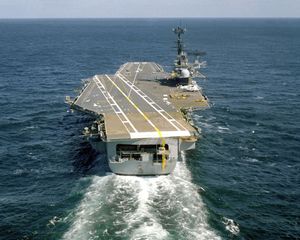The arrival of the USS Independence at the Port of Brownsville has been delayed by fears on the part of environmental regulators that some of the preparations for the ship’s departure from the Puget Sound Naval Shipyard were polluting the water there.
According to a Jan. 10 article from the “Kitsap Sun,” the U.S. Environmental Protection Agency and the Washington State Department of Ecology were concerned that the scraping of the ship’s hull by Navy divers — necessary to limit the spread of invasive species during the 16,000-mile trip to Texas — was putting toxic amounts of copper-based paint into the water and harming marine life.
On Jan. 6, divers began the weeks-long process of scraping a three-inch-deep layer of barnacles and other marine growth from the hull, according to the article. International Shipbreaking Ltd., part of the EMR Group, last August won the Navy contract to dismantle the mothballed “supercarrier,” commissioned in 1959 and decommissioned in 1998.
This will be the company’s third carrier. International Shipbreaking took delivery of the decommissioned USS Constellation in January 2015 and the retired USS Ranger in July 2015.
The Independence originally was scheduled to leave the Navy facility near Bremerton, Wash., under tow roughly two months ago and arrive in Brownsville in late February or mid-March. The original estimate was that the trip would take 4 1/2 months using an ocean-going tugboat.
Robert Berry, International Shipbreaking vice president, said the latest estimate is closer to two months since the company has elected to bring in an actual towing ship, which is faster than a tug. The issue that was preventing the vessel from leaving has been resolved, meanwhile, and the Independence should be ready to embark on its final journey as soon as the tow vessel arrives, he said.
“We don’t know exactly when,” Berry said. “Probably somewhere around the middle of February.”
The trip will take the Independence south from Puget Sound to the tip of South America, where it will navigate the Strait of Magellan before heading north up the eastern coast of South America to the Caribbean Sea, the Gulf of Mexico and finally the Brownsville Ship Channel. Berry said it should be relatively smooth sailing once the vessels get far enough south.
“It’s winter time here (in Bremerton), so it’ll be a little rough getting out of here, but down south its summertime,” he said. “It’s never really good weather down there, but it’s much better weather than normal.”





